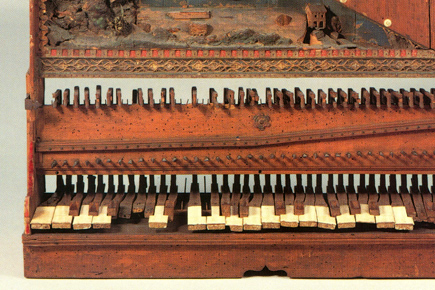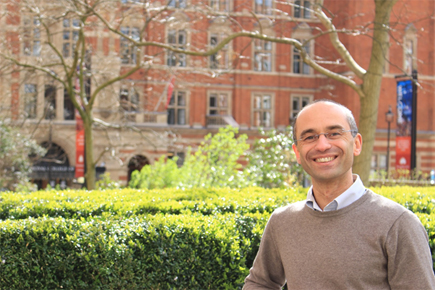Museum blog: Meet the curator
Tuesday 9 May 2017
Name
Gabriele
Who
Curator
Favourite object in the collection
The clavicytherium

Why?
Well, for a start it is very famous and potentially a very important milestone in musical culture. But it's also a huge puzzle! So many questions about it are unanswered. We have expectations and assumptions about this instrument that are shared broadly around the world, and it is our job to find out if they are true. We don't know where the process could lead us! We could find evidence that strengthens our assumptions or find out that we’ve been completely wrong for 150 years. It’s a beautiful question mark.
Do you play an instrument?
I did and I stopped! I studied composition and keyboard from the age of five and then reached the age of 18 and stopped. Now from time to time I put my hands on a keyboard and feel a bit ashamed of myself! Do I keep thinking that I should start practising? Yes. Is it a top life priority? Unfortunately not at the moment.
What are you up to today?
This morning I've been looking over our new website content and doing some planning. We're in a period of preparation for the redevelopment of the Museum over the next four years; budgets, contracts, projects and bringing everything together.
Can you tell us a bit about what you do in the Museum? What your role as a curator is?
The role of the curator is a bit like the role of an orchestral conductor! You need to have your own ideas about how you see the work but you also have to coordinate the efforts of a number of people, each of whom are experts in their field, and everything needs to 'sound amazing' at the end.
I find that, as a curator, it is good to have managerial as well as creative skills, and I try to split my day in two to reflect this. In the morning I do the project management part; thinking about upcoming projects, writing strategies, keeping the Museum relevant to the RCM identity, making sure we produce enough content or 'outputs' to maintain a good reputation for the Museum. I also have to make sure that all the numbers match at the end of the year! In the afternoon I try to understand the collections better, study them, generate new ideas based on what we have that will allow me to create or influence new projects.
What projects have you got going on at the moment?
Of course the biggest one is the museum redevelopment which, besides the main construction work, includes a number of sub-projects (design, digitisation, conservation, learning activities). At the moment we're in the midst of the museum redesign, and we're about to begin recruiting volunteers and placements to assist with the digitisation and conservation work. And the learning activities are also getting off the ground.
We're also about to update the digital identity of the museum, revise the website and launch our online catalogue in a few weeks' time. We're approaching the last six months of our MINIM project which will deliver a single access point to over 20,000 musical instruments in hundreds of British collections. This is a key moment in the life of the project, because by now we should see tangible results coming in and need to organise the final rush towards the closure of the project (and dissemination afterwards).
What is the best bit about your job?
Oh, it changes every day! I love that every day is different, every discussion is different, every month I get to face a world/museum that is different from the month before. I also enjoy that fact that I can dream of a world that I like and try to make it happen through the museum.
On the flipside of that coin, what are the challenges of your job?
Mainly finding a balance between managing the museum and still having the opportunity to explore and study the collection; balancing personal curiosity with institutional priorities. At the same time in my role as 'orchestral conductor' another challenge is ensuring that the final outcome is pleasing for the 'performers' and the 'audience'. And that I’ve enjoyed the process, because if we don’t enjoy it then no-one will!
Many of our readers might not know about the RCM collections, can you tell us a bit about them?
Our collections began as possibly the most fascinating project in music collecting: telling the history of music, or the story of music, through objects. The way that you went about telling the history of music at the end of the 19th century (when our collections started) was through musical instruments, faces of musicians and composers (paintings) and through the music
that they wrote. And these are the main strengths of our collections, it's been a 150 years of collecting – sometimes to high standards, which brought in amazing musical instruments that were available on the market at the end of the 19th century when collecting musical instruments was a new thing, and lovely, rare things were still available.
We've also got very good paintings which came through important donors such as, for example, the Hill family who are one of the most famous families of violin dealers. They had access to some amazing musical iconography which we've been lucky to receive.
What are you most excited about in the Museum's future?
The excitement of a redevelopment project is a bit like the excitement of moving house. You get to be involved in the designing, planning, furnishing, and you can plan what life will be like in that new house! My vision for the 'new house' is of an open house, colourful, noisy, full of people of any age who are excited about music but where you can sit back and relax.
A silly question to finish, but if you could be a musical instrument, what would you be and why?
I'd be a French horn! Loud but also able to be bright, deep, subtle, or sad. French horns look much smaller than they actually are. There's a lot more to them than meets the eye!
Thanks Gabriele, all the best!
Our Meet the Team series continues next week.








